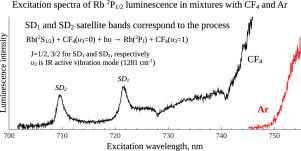Journal of Quantitative Spectroscopy and Radiative Transfer ( IF 2.3 ) Pub Date : 2020-09-16 , DOI: 10.1016/j.jqsrt.2020.107339 V.A. Alekseev , A.A. Pastor , A.S. Pazgalev , P.A. Petrov , P.Yu. Serdobintsev , T.A. Vartanyan

|
The absorption and luminescence excitation spectra of gas phase mixtures of alkali metals atoms A (A = K, Rb, Cs) with carbon tetrafluoride molecules CF4 are studied in the region of transitions from the ground state A(2S1/2) to the lowest resonance states A(2P1/2, 3/2). It is shown that these transitions have intense satellites corresponding to the simultaneous vibrational excitation of the carbon tetrafluoride molecule, A(2S1/2) + CF4(v3=0) + hv → A(2P1/2, 3/2) + CF4(v3=1), where v3 is the IR active mode of CF4 with a vibrational quantum energy of 1281 cm–1. The satellites are relatively narrow bands (FWHM ~ 30 cm–1) slightly (< 10 cm–1) shifted to the red from the energies corresponding to the asymptotes A(2PJ) + CF4(v3=1), J=1/2, 3/2. The spectral width and position of the satellites indicate that these transitions occur at relatively large atom-molecule distances. In contrast to the majority of the studied before pair excitation processes in the gas phase, the intensity borrowing mechanism responsible for the observed satellite bands cannot be explained by the dipole-dipole interaction. Possible alternative mechanisms are discussed. It is also established that mixtures with CF4 are chemically stable including at elevated temperatures up to at least 200°C and their optical excitation results in resonance luminescence of alkali atoms. As compared to Ar, collisions with CF4 provides a higher rate of the population transfer between the A(2P1/2) and A(2P3/2) states. These results indicate that CF4 may be used as a component of the active medium of diode pumped alkali lasers.
中文翻译:

与CF 4混合物中碱原子共振跃迁的卫星
研究了碱金属原子A(A = K,Rb,Cs)与四氟化碳分子CF 4的气相混合物在从基态A(2 S 1/2)到跃迁区域的吸收和发光激发光谱。最低共振状态A(2 P 1/2,3/2)。结果表明,这些跃迁具有强烈的卫星,对应于四氟化碳分子同时振动激发,A(2 S 1/2)+ CF 4(v 3 = 0)+ hv →A(2 P 1/2,3 / 2)+ CF 4(v3 = 1),其中v 3是CF 4的IR激活模式,其振动量子能为1281 cm –1。卫星是相对窄的频带(FWHM〜30厘米-1)稍微(<10厘米-1)移动到从对应于该渐近线A(能量红色2 P Ĵ)+ CF 4(v 3 = 1),Ĵ= 1 / 2、3 / 2。卫星的光谱宽度和位置表明这些跃迁发生在相对较大的原子-分子距离处。与气相中成对激发过程之前研究的大多数相反,负责观测卫星带的强度借用机制不能用偶极-偶极相互作用来解释。讨论了可能的替代机制。还确定了与CF 4的混合物在包括高达至少200℃的高温下是化学稳定的,并且它们的光激发导致碱原子的共振发光。与Ar相比,与CF 4的碰撞在A(2 P 1/2)和A(22 P 3/2)状态。这些结果表明,CF 4可用作二极管泵浦碱金属激光器的活性介质的成分。


























 京公网安备 11010802027423号
京公网安备 11010802027423号